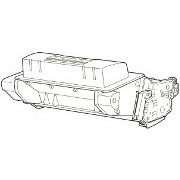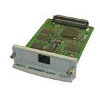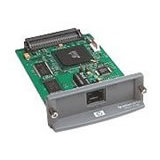HP Original Cartridges
JetDirect EIO Cards
JetDirect 620n are still available new from distributors in July 2015 but the price is a strong incentive to buy a "refurbished" card.
Error Message 22 for HP P4014, P4015 and P4515 Series Printers.
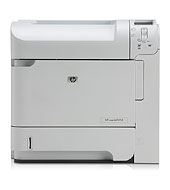
EIO Cards are HP's expansion bus for printers. There is more on EIO here.
22 EIO X BUFFER OVERFLOW "To Continue Press OK"
The message 22 EIO X BUFFER OVERFLOW "To Continue Press OK"- Data will be lost
.
22 EMBEDDED I/O BUFFER OVERFLOW "To Continue Press OK" - Too much data sent for the internal JetDirect
22 USB I/O BUFFER OVERFLOW "To Continue Press OK" - Too much data sent for the internal JetDirect.
Digital devices are full of buffers, locations where data can be stored temporarily whilst waiting for the next stage in a chain of processing events. There are byte or packet sized buffers in the SERDES elements of communications hardware. There can be kilobytes or even megabytes of space on communication cards. One of the arguments for big buffers in printing is that a print job can be sent all in one go, freeing the users computer to get on with other things.
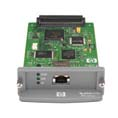
HP Enhanced Input Output cards (EIO) are usually independent little computer systems plugged into the printer formatter - which is a larger and more complex computer. The EIO card deals with the communications line or a peripheral like a disk whilst the formatter gets on with turning the print language into a framebuffer ready to be scanned out by the laser (or by the printheads in a DesignJet).
The use of independent communications processors dates back to the 1960s (CDC 6600 PPUs), so techniques for buffering are well developed and rarely go wrong these days. However they could go wrong in priciple.
The "22" errors are odd. If the printer can't store a packet it might either not request it or acknowledge it - whatever the protocol in use requires to make the sending device back off. HP don't make it clear how this error could happen so we can only speculate.
One answer is that when software is first written it could go wrong and the printer design team may have felt the need to trap buffer overflow situations that should never happen in the production version of the machine.
Another explanation is that not everything in the computer world is a finished and fully tested product. Whilst the TCPIP stacks for the main operating systems Windows, Unix, Linux and Apple are well tested they sometimes are shown to have defects. There are many experimental systems out there so the printer might see circumstances that would create buffer overflow.
Most probably buffer overflow relates to an unexpected and unwanted print protocol. Something is sending data intended for another printer? Or sending packets that are never going to get a reply because the printer does not know what to do with them but that occupy buffer space.
We presume that the I/O tasks run independently and asynchronously to the language interpreters responsible for page formatting so that it is possible for them to simply overrun the memory space available.
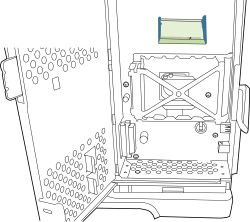
Remedies
This error seems to be fairly exceptional so if it happens the immediate answer is probably to turn the printer off, wait ten seconds, turn it on again and with hope in you heart send the print job again.
Possible answers to the problem if it repeats are:
- Simplest action is to simplify the page you are sending, drop from 1200dpi to 300dpi resolution. Or don't send the job when you know the printer is being asked to do others.
- There are a great many network protocols such as IPX/SPX, Appletalk and DLC/LLC most of which are largely of historical interest but are supported on printers to ensure they will work with old kit. Turn off protocols that are not needed on both the PCs and the printer. This is particularly important with the J6057A HP Jet Direct 615N EIO cards which can apparently shut down with this error or40 EIO X BAD TRANSMISSION (below).With EIO cards (which slide into the back of the printer) it is possible to try a replacement network card. They are available here.
- Upgrade the firmware for the EIO card, printer or both in the hopes that the wierd combination of events that sets this error off is now dealt with more gracefully
- Give the printer more memory (since you cannot upgrade that on the EIO card
- Use a different network card - so if you are using embedded try an EIO card in the slot. If you are using a Jetdirect 620 then try a JetDirect 625.
Web Research
"22 errors" are not all that common. Querying Google with P4014 "22 EIO X BUFFER OVERFLOW"
gave About 223 results
which is a moderate response.
- HP Support. The official Control Panel Messages page for LaserJet P4010 and P4510.
- HP 5100 page HP's Control Panel Messages page for LaserJet 5100. As said it is difficult for search engines to distinguish between printers if they all share the same error messages.
- MindMachineOne of the pages I'm working to improve.
- manualslib. another of manualslib's rips of the service manual. Putting individual manual pages online like this is more helpful than nothing, but it's inconveniently slow and the download buttons are dodgy.
- ManualOwl had a ripped page here which still gets search rank but has gone.
- all-laser.com combination of cut-and-paste with some original material.
- laserprinterhelp.net page seeded from (based on) the service manual with information page- scraped, a set of irrelevant links and no feedback as yet.
-
former href="http://www.hp-parts.com
powershow Powershow or hp-parts.com as they style themselves. This apeared to be the LJ 4000 manual again - but in October 2013 the domain dissapeared. - highspeedbackbone rip off copy of the user guide.
- platen.com legal ? copy of the service manual.
None of the pages examined gave any real explanation of what the issue is. Somehow or other the printer managed to accept too much data.
Copyright G & J Huskinson & MindMachine Associates Ltd 2013, 2015. Some pictures derived from HP User and Service guides. These technical pages do not constitute an offer for sale; just our knowledge at the time of writing. See the catalogue. Sales pages on this Web site use cookies to store user information. We also use Google Analytics to track site usage patterns.

